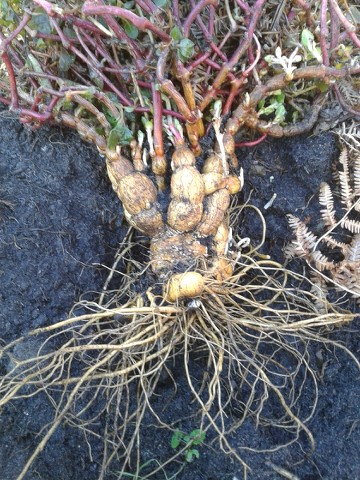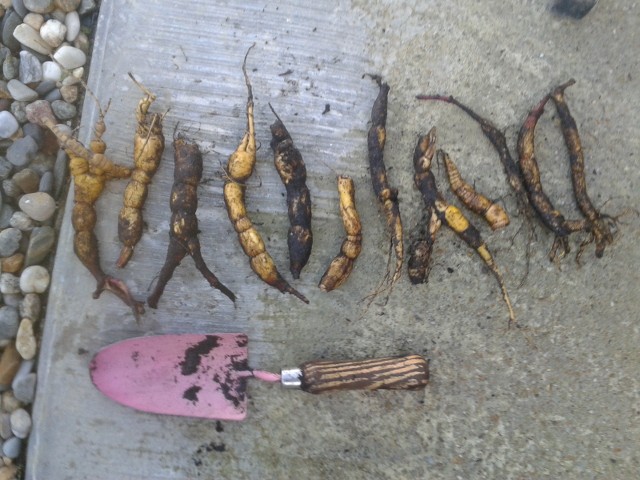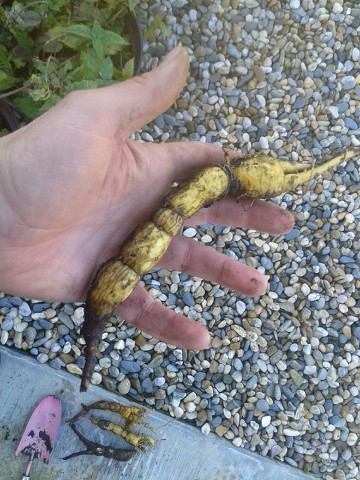|
|
Post by billw on Nov 11, 2016 12:32:21 GMT -5
Ulluco yields similarly to potato in the Andes. We struggle with it because of climate, but hopefully this is a step toward closing the gap.
Steev, the flavor of ulluco does not vary much between varieties. It is kind of like a combination of potato and beet, with a different texture that is more crisp and watery when raw, but closer to a boiled nut when cooked. Like most vegetables, it is really difficult to describe it in terms of other vegetables without being misleading.
|
|
|
|
Post by billw on Nov 28, 2016 23:22:38 GMT -5
This year's new ullucos. You have already seen one that I previously posted, now named Taholah. The rest will be kept as breeding lines. I think the most interesting result is the large number of white varieties. I haven't gotten any whites from first generation crosses - they have only showed up from second generation seed. Sample size is too small to draw any conclusions, but since ulluco is diploid, it shouldn't be too difficult to work out the color genetics. Germination from second generation seed was almost 5%, so either I'm getting better at germinating them or they are increasing in fertility. Maybe both.  |
|
|
|
Post by steev on Nov 29, 2016 1:08:18 GMT -5
I'm so impressed; clearly you have good conditions for ulloco, as well as oca; don't know that I ever will, between climate (on the farm) and squirrels (in the East Bay).
Even if those were mediocre food, they're stunning. Are they good thin-sliced in salad or whatever, or must they be cooked; if so, how does that affect their color?
I admit to being a shallow kind of guy who thinks pretty is good.
|
|
|
|
Post by prairiegardens on Nov 29, 2016 1:15:38 GMT -5
Those look WONDERFUL! I was wondering at first if you had stained them for identification or something. Waiting to hear the answers to Steev's questions... may have to try to track some down...
|
|
|
|
Post by steev on Nov 29, 2016 1:33:44 GMT -5
Answers, or tubers? billw would have those, one hopes.
|
|
|
|
Post by billw on Nov 29, 2016 1:33:56 GMT -5
Well, the long game here is to breed for wider climate tolerance. I think I've already had some modest success with oca, but ulluco will be more challenging because it is so damned difficult to get any seed out of it.
I think food ought to be tasty, nutritious, and beautiful. There isn't any reason to compromise on any of them as far as I'm concerned.
Cooking washes out a lot of the color of ulluco, but there are ways to preserve it better by acidifying cooking water or blanching. I like it best cooked, but it is pretty good raw as well - vaguely like water chestnut. It looks great in a salad.
Some varieties are more mucilaginous than others and those aren't very appealing raw. There is quite a range of both that and the beet/geosmin flavor in the new varieties.
|
|
|
|
Post by steev on Nov 29, 2016 2:27:58 GMT -5
Well, that's very encouraging, alltogether.
Can't say mucilaginous appeals much to me, either; but anything decent and pretty in a salad is great.
|
|
|
|
Post by khumlee on Dec 4, 2016 13:53:42 GMT -5
Mauka News Second years  This on come from split of last year, This is the second years of growing season. (800gr -1,78) And look to the native picture of mauca below. I'm so happy to see that.  From granoandino.blogspot.fr/2013_10_01_archive.htmlAnd I think I have understand that it was very important to put the first year plant under 15 to 20 cm of earth, for increase the size of the edibles stems.   Here split of this year, plant under 20 cm of earth too. See next year |
|
|
|
Post by billw on Dec 4, 2016 14:28:36 GMT -5
Nice! You can cut up those caudices even further at the joints. Each one will make a plant.
|
|
|
|
Post by gilbert on Dec 17, 2016 18:28:10 GMT -5
I'd like to work on making one of the Andean root crops a reliable calorie staple for the Denver/ High desert front range climate. From what I've heard, parts of the Andes have a somewhat similar climate. Which crops would be most likely to succeed? Which are most calorie dense? Are they more like potatoes in that regard, or more like turnips?
|
|
|
|
Post by billw on Dec 22, 2016 14:23:57 GMT -5
Because the Andes are a tropical mountain range, the climates actually aren't very similar. Although the climate is cool, it rarely freezes and there is a year round growing season in most places. Because of that, Andean crops tend to have little to no frost resistance but require a long growing season. The Andes share a lot more in common with the maritime Pacific Northwest. So, for your project, you would want to look for crops that can tolerate a short growing season and that have some frost resistance. That rules out most of the tuber crops. You might look at mauka and maca. While mauka doesn't have much frost resistance, it is a tough plant that can yield well in six months if grown in rich soil. It tolerates more heat, wind, and drought than most Andean crops. Maca is another that might be worth a shot. It has some frost resistance and it grows at very high elevations where the weather is unreliable. The only problem is that it wants a growing season of about 9 months. I think it is probably possible to bring that down with a few years of selection.
|
|
|
|
Post by gilbert on Dec 22, 2016 18:52:24 GMT -5
Thanks Bill!
Do you know what the weather is like in the far Southern Andes? I'm wondering if it would be a bit more Denver like. But I suppose it would also be wetter. Are there crop accessions from that area?
|
|
|
|
Post by rowan on Jan 17, 2017 0:33:38 GMT -5
Hey Bill, how about a new thread for 2017.
Anyway, for those growing Ulluco. Most of my plants collapsed and I found they had rotted off just below soil level. No problem as I just replanted the stems and they are shooting again They grow ridiculously easy from cuttings) but now way behind in growth. Last year I had none of this and the summer was hotter, and hotter for longer so I am not convinced that it is our heat doing this. My current hypothesis is a fertiliser issue. Last year they were put in unfertilised beds in my poor soil and did fabulously. This year I fertilised before planting. Has anyone had fertiliser issues with ulluco? if so, what would be the main nutrient problem.
|
|
|
|
Post by steev on Jan 17, 2017 1:03:19 GMT -5
Weird; wild-flowers have been shown to be often adversely affected by being coddled and treated too well; interesting that a domesticated plant would be so; that seems to go against the flow: that our crops need to be coddled.
|
|
|
|
Post by billw on Jan 17, 2017 1:12:08 GMT -5
I don't give ulluco anything stronger than well composted horse manure, but I don't give anything amendments stronger than well composted horse manure.  Most of the Andean crops were typically grown in rotation, following a potato crop that followed fallowing for several years. That suggests that they haven't been bred to rely upon high soil fertility. I haven't seen any indication that fertilizers were common. Not a lot of large mammals in the Andes to supply manure. I rely on high levels of organic matter to smooth over the deficiencies in my soil, which are manifold. That said, the symptoms that you describe sound like bacterial rot. Perhaps that was brought on by rich soil, or perhaps this just wasn't a lucky year. Many people have observed similar symptoms in hot, dry weather. |
|